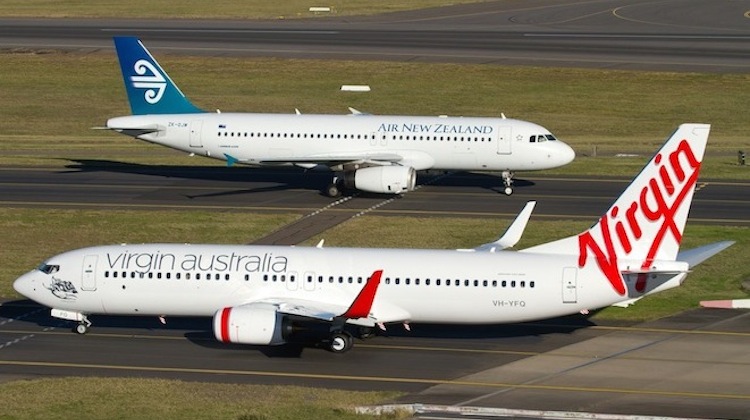
Air New Zealand and Virgin Australia are ending their alliance on trans-Tasman routes.
The partnership is due to expire in October 2018 and both airlines said on Wednesday they would not seek an extension of the tie-up from the Australian Competition and Consumer Commission (ACCC).
Virgin Australia said in its statement it had “received notice that Air New Zealand intends to end the strategic alliance between Virgin Australia and Air New Zealand”.
The Australian carrier said the two carriers would work through arrangements regarding codeshare, scheduling, inflight offering, lounge access and frequent flyer program reciprocity to ensure minimal disruption to customers.
Air New Zealand chief revenue officer Cam Wallace said in a separate statement market dynamics on the Tasman had changed, adding that the time was right for each airline to “focus on its own objectives”.
The alliance was established seven years ago, and involved a metal-neutral, revenue-sharing joint-venture on on trans-Tasman routes, as well as reciprocal frequent flyer benefits.
At the time, both Air New Zealand and Virgin Australia spruiked consumers would benefit from a better choice of flights, improved connections and increased capacity on the Tasman.
Further, it would also allow the airlines to leverage efficiencies, opportunities and cost savings on trans-Tasman operations.
The ACCC approved the renewal of the alliance for five-year period through to October 31 2018 in 2013.
The 2013 authorisation noted Air New Zealand and Virgin Australia had the largest combined market share on Australia-New Zealand routes with 50.8 per cent of all seats flown on the Tasman. Air New Zealand held 35 per cent of all capacity, while Virgin Australia had 15.4 per cent.
The next largest grouping on trans-Tasman routes was the combined capacity share of Emirates, Jetstar and Qantas.
At the time, Air New Zealand held a 23 per cent of Virgin Australia shares. It has also twice supported the Australian carrier alongside other major shareholders Etihad Airways and Singapore Airlines through backing a capital raising or an unsecured loan facility.
The partnership between the pair deepened in 2014, when Air New Zealand, then with a 26 per cent shareholding, took a seat on the Virgin Australia board.

However, relations soured in March 2016 when Air New Zealand announced it planned to sell its stake in Virgin Australia and resigned from the board.
While the two airlines have been at pains to stress in the two years since Air New Zealand left the share registry that the alliance arrangements would be unchanged, there has been some winding back of cooperation, particularly in terms of frequent flyer benefits and earn and burn opportunities on each other’s networks.
Wallace noted Australia was the largest source of inbound visitors to New Zealand, adding that Air New Zealand had built up a significant presence in this market.
“This move will enable us to deliver a more consistent customer experience by using our own fleet and delivering an improved schedule, which we’ll provide more details about shortly,” Wallace said.
“We remain fully committed to our other alliance relationships and our overall global airline alliance strategy as a critical success factor in other markets.”
Air New Zealand has been aggressively targeting Australia in recent times and in 2016 launched a marketing campaign designed to capture a larger slice of Australians heading to North and South America.
VIDEO: An example of Air New Zealand’s “Better Way to Fly” campaign targeting Australians, as shown on the airline’s YouTube channel.
That push followed the start of nonstop flights to Houston and Buenos Aires from its Auckland hub in December 2015. And by the end of this year Air New Zealand plans to add Chicago to its North American network alongside Los Angeles, Houston, San Francisco and Vancouver.
For Virgin Australia, chief executive John Borghetti said the end of its tie-up with Air New Zealand on trans-Tasman route provided “opportunities for the Virgin Australia Group on the Tasman, including operating both the Virgin Australia and Tigerair Australia brands in the market”.
“The Virgin Australia Group has had a strong presence in the market since 2004 and we will continue to enhance our offering to suit both the business and leisure markets,” Borghetti said.
“Virgin Australia will continue its strong focus on providing competition and outstanding service on the Tasman, which remains an important part of our network and strategy as an airline group.”
In addition to their alliance on the Tasman, Virgin’s Boeing 737-800s and ATR 72 turboprops undergo maintenance checks at Air New Zealand’s engineering workshops in New Zealand. The pair also has a shared Boeing 777-300ER engine pool.
Currently, Virgin Australia’s low-cost-carrier unit Tigerair Australia has no international routes, having ended flights to Bali in February 2017 after reaching an impasse with Indonesian regulators over its operating permit to serve the popular tourist destination.
Any re-entry into the international market would allow Virgin Australia to offer both a full-service and bust option for travellers on the Tasman, while at the same time help improve the utilisation of Tigerair Australia’s Airbus A320s and Boeing 737-800 fleet.
















